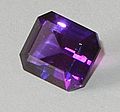Amethyst (color) facts for kids
| This box shows the colour amethyst. |
|---|
- For other meanings of the word, see Amethyst (disambiguation).
The color amethyst is a medium, clear purple. It is also known as a darker shade of lavender. Its name comes from the stone amethyst. This stone is a type of quartz, but it is not always purple. Amethyst was once a very special and valuable stone before people found more of it.
Contents
What is the Color Amethyst?
The color amethyst is a beautiful shade of purple. It gets its name from the gemstone amethyst. This color is often seen as calm and royal. It is a popular color in fashion and art.
How is Amethyst Color Made?
Colors like amethyst are made by mixing other colors. On computer screens, amethyst is made from red, green, and blue light. It uses 60% red, 40% green, and 80% blue. For printing, it uses different inks: 25% cyan, 50% magenta, 0% yellow, and 20% black.
What are the Color Codes for Amethyst?
Every color has special codes that help computers and printers know exactly what shade it is. For amethyst, these codes are:
- Hex triplet: #9966cc (This is a common code for websites)
- RGB Decimal: 153, 102, 204 (This shows the amount of red, green, and blue light)
- RGB Percent: 60%, 40%, 80%
- HSL: 270°, 50%, 60% (This describes the color's hue, brightness, and how strong it is)
Amethyst as a Gemstone
The gemstone amethyst is a type of quartz. It is famous for its beautiful purple color. Amethyst crystals can be found in many places around the world. They are often used in jewelry.
Where Does Amethyst Come From?
Amethyst forms inside rocks. It gets its purple color from small amounts of iron inside the quartz. When the iron is exposed to natural radiation, it changes the color of the crystal. The color can range from light lilac to deep purple.
Why Was Amethyst So Special?
For a long time, amethyst was a very rare and valuable gemstone. Only kings and queens could usually afford it. It was seen as a symbol of royalty and wealth. When more amethyst was discovered in places like Brazil, it became more common. This made it available to more people.
Amethyst in Nature and Everyday Life
The color amethyst is not just found in gemstones. You can see similar shades of purple in many places. It appears in nature, art, and even in things we use every day.
Amethyst in Flowers and Plants
Many flowers show beautiful shades of purple, similar to amethyst. For example, lavender flowers are a well-known example. Wisteria and periwinkle also have lovely purple blooms. These colors add beauty to gardens and natural landscapes.
Amethyst in Other Objects
You might see amethyst-like colors in other everyday items. Some fruits, like plums, have a deep purple skin. Even some money, like the Indian 100-rupee note, uses shades of purple in its design. This shows how common and appealing the color amethyst is.
Images for kids
-
Soap bars with lavender from Provence.
-
Chinese wisteria.
-
Wisteria close-up.
-
Lavender pink roses.
-
Plum fruits.
-
A lavender flower.
-
Faceted amethyst.
-
Mountain view at Auke Bay, Alaska showing distinctive purple tinges.
-
Lavender Heights in Sacramento, California.
















